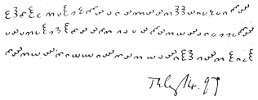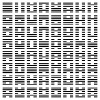Johann Sebastian Bach - Crab Canon

Symmetry is a fundamental concept, a mapping of an object which preserves its structure. A central figure is the precocious genius Évariste Galois, who laid the mathematical cornerstones of group theory, yet lost his life in an impetuous duel.
And symmetry also finds illustration throughout musical history, perhaps best in the canon forms, including the intricate reversals, inversions, tempo scaling, and transpositions of Bach's offerings.
Edward Elgar - The Enigma Variations

Elgar's variations embed coded themes about the composer's friends, and included a 'theme' throughout which cryptically references another melody. This riddle has yet to be discovered.
Codes are widely used in communication, with Claude Shannon's seminal work on information theory setting up the mathematical basis. Shannon was incidentally also known for riding his unicycle down the halls of the Bell Laboratories.
John Cage - Music of Changes

In mathematics, randomness underlies key concepts in probability, statistics, and the behaviour of complex systems. The mathematics of stochastic processes have been deeply explored by Andrey Nikolaevich Kolmogorov. He encouraged independence of thinking by never explaining, simply posing problems to his students.
John Cage experimented with such indeterminancy in music; not just the use of the haphazard in composition, but the performance itself, so that the listener's framing of the piece supercedes the composition itself. Cage writes: "Wherever we are, what we hear is mostly noise. When we ignore it, it disturbs us. When we listen to it, we find it fascinating."
They Might Be Giants - Infinity

TMBG are known for their absurdist ditties, and here sing about counting infinity. Even if it takes "tons of patience".
But Georg Cantor, who formalized infinity as a mathematic idea, showed that there are also infinite sets which are uncountable. Georg Cantor was at the time described as a "corrupter of youth".
Kate Bush - Pi

The two beautiful constants, π and e, appear in equations with astonishing frequency, most notably in the identity named after Leonhard Euler. Of course, so many mathematical discoveries are named after Euler that it can get quite confusing.
Sadly, the production of Kate Bush's ode to Pi has edited out a segment out of those first hundred and fifty digits, like fixing a cubist painting with a pair of scissors. But what better expression for a transcendent number than an ethereal voice in musical recitation?